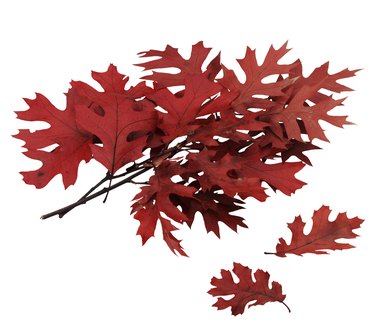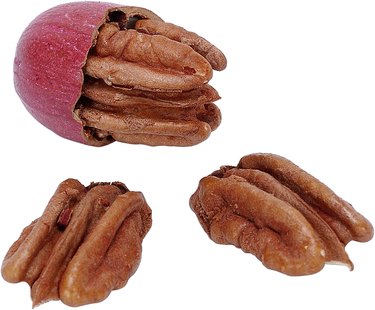
Oak trees (Quercus spp.) are in the Beech, or Fagaceae, botanical family. Hickory trees (Carya spp.) are in the Walnut, or Juglandaceae, family. The hickory was botanically reclassified into the same order – Fagales – as the oak, but hickory and oak remain in separate genera. Hickory is a hardwood prized for its use to make tool handles. It was the principle wood used for American pioneer-era wagon wheels. Its aroma when burned makes it a favorite for smoking meats. Oak is a major source of hardwood for flooring, furniture, cabinets, beams and barrels.
Species
Video of the Day

Both oaks and hickories have species that thrive in U.S. Department of Agriculture (USDA) plant hardiness zones 4 through 9, although live oaks (Quercus virginiana) are hardy only in USDA zones 8 through 11. One of the most common oak species is the native white oak (Quercus alba), which is hardy in USDA zones 3b through 8. Hickory nut trees include the pecan (Carya illinoensis), which grows in USDA zones 5b through 9a, and the native shagbark hickory (Carya ovata), which is hardy in USDA zones 4 through 8.
Video of the Day
Habit
Both oak and hickories are large trees with taproots. When first planted, they show little top growth because all their energy is concentrated on forming a strong root system. Oak leaves are variable; some are lobed and others have serrated edges. Oaks' male flowers are catkins while their female flowers are tiny blooms above the ovary that becomes an acorn. On hickory trees, both male and female flowers are catkins, and hickory leaves have finely serrated edges with tiny hairs.
Culture
Both kinds of trees grow best in deep, well-drained, humus soil, but neither kind of tree is fussy about soil type. Deep irrigation to promote deep rooting is required for the trees to thrive. They should be soaked with 10 gallons of water weekly for at least two years to establish them in their location.
Landscape Use
Hundreds of oak trees species are native to North America, and they commonly are planted in landscapes as shade trees and a food source for wildlife. Oaks grow 50 to 120 feet tall and can live more than 200 years. Hickory trees also provide shade but usually are planted only by people who wish to harvest their nuts. They are considered messy trees that drop leaves, twigs and fruit. Hickories reach 40 to 80 feet tall.
Nuts
Hickory trees' fruit – hickory nuts and pecans – are edible for humans and considered tasty. They are encased in rough, ridged husks. The fruit of oak trees, the acorn, is an important food for wildlife, from bluejays and squirrels to deer, raccoons and wild turkeys. Similar animals feed on hickory nuts, which are said to be preferred to acorns.
- Iowa State University Extension and Outreach: Walnut and Hickory Trees
- IPM for Select Deciduous Trees in Southeastern U.S. Nursery Production; Amy F. Fulcher and Sarah A. White, Editors
- University of Michigan Herbarium: Quercus
- University of Michigan Herbarium: Carya
- Southern Pride Tree Farm Inc.: Live Oak Tree Frequently Asked Questions
- University of Florida IFAS Extension: The Value of Oaks to Wildlife
- Missouri Department of Conservation: Missouri’s Hickories
- U.S. Department of Agriculture, Forest Service: Carya Illinoensis, Pecan
- Missouri Botanical Garden: Carya Ovata
- U.S. Department of Agriculture, Forest Service: Quercus Alba, White Oak